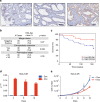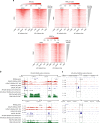Acetylated histone variant H2A.Z is involved in the activation of neo-enhancers in prostate cancer
- PMID: 29116202
- PMCID: PMC5676741
- DOI: 10.1038/s41467-017-01393-8
Acetylated histone variant H2A.Z is involved in the activation of neo-enhancers in prostate cancer
Abstract
Acetylation of the histone variant H2A.Z (H2A.Zac) occurs at active promoters and is associated with oncogene activation in prostate cancer, but its role in enhancer function is still poorly understood. Here we show that H2A.Zac containing nucleosomes are commonly redistributed to neo-enhancers in cancer resulting in a concomitant gain of chromatin accessibility and ectopic gene expression. Notably incorporation of acetylated H2A.Z nucleosomes is a pre-requisite for activation of Androgen receptor (AR) associated enhancers. H2A.Zac nucleosome occupancy is rapidly remodeled to flank the AR sites to initiate the formation of nucleosome-free regions and the production of AR-enhancer RNAs upon androgen treatment. Remarkably higher levels of global H2A.Zac correlate with poorer prognosis. Altogether these data demonstrate the novel contribution of H2A.Zac in activation of newly formed enhancers in prostate cancer.
Conflict of interest statement
The authors declare no competing financial interests.
Figures









Comment in
-
Prostate cancer: H2A.Zac activates neo-enhancers.Nat Rev Urol. 2018 Jan;15(1):3. doi: 10.1038/nrurol.2017.202. Epub 2017 Nov 28. Nat Rev Urol. 2018. PMID: 29182604 No abstract available.
References
Publication types
MeSH terms
Substances
LinkOut - more resources
Full Text Sources
Other Literature Sources
Medical
Molecular Biology Databases
Research Materials

